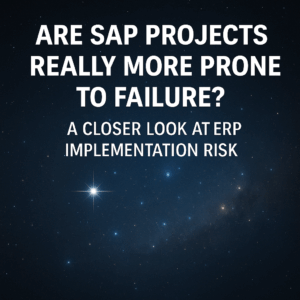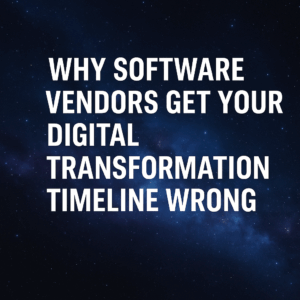A few weeks ago, Revlon announced that its SAP implementation was a disaster. This came on the heels of delayed financial reporting because of said SAP implementation failure.
The company’s stock fell 6.9% within 24 hours of reporting the news, which led to an investor lawsuit against the company. Not good, especially for a publicly-traded and well-known consumer product company.
Revlon is the latest in a string of recent ERP and SAP failures. Lidl, National Grid, Hertz, and Haribo are just a few other companies that have experienced such challenges. So, what is the problem with Revlon, these other companies, and the ERP industry in general? Unfortunately, there is a lot wrong with the industry – and Revlon’s SAP failure is a symptom of a deeper problem.
Here are a few findings and lessons from Revlon’s SAP implementation disaster:
Table of Contents
ToggleImplementation risks should be well understood, quantified, and mitigated
Revlon, like many companies implementing SAP S/4HANA and other ERP solutions, didn’t seem to understand the risks associated with their transformations. Worse yet, they must not have quantified or implemented effective strategies to mitigate those risks.
In this case, Revlon experienced shipping delays and lost sales due to production stoppages at its North Carolina plant – the location of the first phase of its SAP go-live. Here is an excerpt from Revlon’s quarterly financial filings to the SEC:
During February 2018, the Company launched the new ERP system in the U.S., which caused its Oxford, N.C. manufacturing facility to experience service level disruptions that have impacted the Company’s ability to manufacture certain quantities of finished goods and fulfill shipments to several large retail customers in the U.S. The Company cannot provide assurances that it will remedy the ERP systems issues in time to fully recover these sales and/or that the ERP implementation will not continue to disrupt the Company’s operations and its ability to fulfill customer orders.
Also, these ERP-related disruptions have caused the Company to incur expedited shipping fees and other unanticipated expenses in connection with actions that the Company has implemented to remediate the decline in customer service levels, which could continue until the ERP systems issues are resolved. To the extent that these disruptions occur in larger magnitudes or continue to persist over time, it could negatively impact the Company’s competitive position and its relationships with its customers and thus could have a material adverse effect on the Company’s business, prospects, results of operations, financial condition and/or cash flows.
Had Revlon understood, quantified, and mitigated the inherent ERP implementation risks, it would have taken action to ensure that its go-live didn’t materially affect its operations. As one company recently realized, this clear understanding can explain how to save $5M (or more) on your ERP implementation.
Underlying operational issues can ruin an SAP implementation
Prior to implementing SAP, Revlon had some significant operational issues related to its acquisition and integration of the Elizabeth Arden brand. As it outlined in its financial filings, it was having trouble integrating the operations, processes, and organizational structure with its newly acquired company. An SAP implementation is likely to fail against this type of backdrop.
Instead of focusing on the futile attempt to rollout new SAP ERP software, the company should have built a stronger business blueprint and foundation for the overall transformation. This would have begun with defining how with Elizabeth Arden would fit into its overall operations, as well as defining clear business processes for the implementation. This SAP S/4HANA implementation readiness phase is a critical – but often overlooked – ingredient to transformation success.
“Lack of design and effective controls” = unacceptable SAP implementation results
In addition to operational and merger integration issues, Revlon also reported that it had “material weaknesses” with its internal controls as a result of its SAP implementation. This is every CFO’s nightmare – especially for a publicly-traded American company under the watch of Sarbanes-Oxley and other regulations.
Again, the way to avoid these types of issue is to ensure a successful business blueprint prior to beginning an SAP or ERP implementation. To clarify, this is different than an “SAP Blueprint” as defined by SAP’s Activate methodology. As research from our 2019 ERP Report reveals, clearly defined business processes – not software design processes – are the most effective way to mitigate the risk of operational disruption:
Negative ROI shouldn’t be an acceptable SAP implementation outcome
As if the above weren’t enough, perhaps the nail in the coffin for Revlon’s SAP implementation disaster is the fact that it realized a negative return on investment for the transformation. In addition to a breakdown in operational controls and production issues at its North Carolina Plant, Revlon also reported that:
- The company was unable to recover lost sales from the SAP failure
- Customer service levels were disrupted
- There were increased demands on its management team and staff, which cannibalized focus on other corporate priorities
- It incurred significant capital and operating expenditures
- It experienced difficulty processing payments to vendors
- It was unable to fulfill federal, state and local reporting and filing requirements in a timely or accurate manner
- It had greater than expected expedited shipping fees – resulting from the customer firefighting stemming from the SAP failure
- It suffered from an “inability to fill customer orders accurately or on a timely basis, or at all” (emphasis added)
I can’t say for sure, but I suspect this isn’t what Revlon’s management team signed up for.
Conclusion: SAP implementation failures can be avoided
It may be tempting to blame the SAP software or whoever the system integrator was, but Revlon and others should recognize that they ultimately have to own the results of these sorts of transformations. The good news is that SAP failure can be avoided. Our experience with and lessons from successful SAP S/4HANA implementations prove this.
We are currently helping several large companies through their SAP S/4HANA journeys, so I would be happy to compare notes and share some lessons from these and other projects. Contact me anytime to discuss – I am happy to be a sounding board for your digital transformation!





